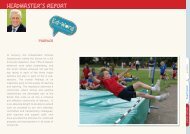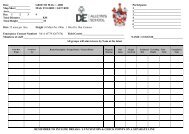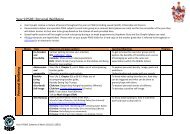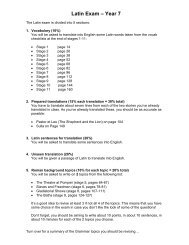Lent Heartbeat - Alleyn's School
Lent Heartbeat - Alleyn's School
Lent Heartbeat - Alleyn's School
Create successful ePaper yourself
Turn your PDF publications into a flip-book with our unique Google optimized e-Paper software.
340 D D Briana and A Malamitsi-Puchner EUROPEAN JOURNAL OF ENDOCRINOLOGY (2009) 160piglets, while leptin supplementation partially reversedthe IUGR phenotype, by correcting growth rate andbody composition in the offspring (95). Furthermore, inthe sheep fetus, moderate maternal undernutrition doesnot seem to influence fetal plasma leptin levels, whilesevere maternal undernutrition leads to suppression offetal leptin synthesis, secondary to profound fetalhypoglycemia or hypoinsulinemia (96, 97). It is possiblethat IUGR may alter the expression of appetitestimulatingneuropeptides in the fetal brain, programmingsusceptibility to adult obesity (55).Taken together, these data indicate that intrauterineexposure to either intrauterine hypo- or hyperleptinemiamay program central or peripheral energyregulatingsystems, predisposing to postnatal obesity.Adiponectin in IUGRAdiponectin is one of the most abundant adipose tissuespecificproteins and is predominantly expressed andsecreted from adipose tissue (98). Adiponectin ispostulated to play a role in the modulation of glucoseand lipid metabolism in insulin-sensitive tissues (99).Circulating adiponectin concentrations decrease ininsulin-resistant states, including type 2 diabetes (99,100). Unlike leptin, adiponectin concentrations areinversely correlated with body weight and the amountof fat mass (101). Moreover, recent findings indicatethat adiponectin has antiatherogenic and anti-inflammatoryproperties (102).In addition to regulating body metabolism, adiponectinis also produced within the intrauterineenvironment (52, 103–105). The findings that adiponectinis present in cord blood (103), positivelycorrelates with birth weight (52, 104), and is highlyproduced by both the placenta and the fetus (52, 105)suggest that this adipocytokine may play a key role infetal growth, probably enhancing the growth-promotingeffect of insulin through its insulin-sensitizing action(52). The high fetal adiponectin concentrations may beattributed to the lack of negative feedback on adiponectinproduction, resulting from the lack of adipocytehypertrophy, low percentage of body fat, or a differentdistribution of neonatal fat depots (106, 107). On thecontrary, other investigators failed to demonstrate arelationship between fetal adiponectin and birth weight(103).Given the significance of glucose and insulin in fetalgrowth (108) and the fundamental role of adiponectinin insulin metabolism (99, 100), it is reasonable toassume that adiponectin may play a regulatory role inIUGR. A number of studies (71, 103, 106), includingour published data (80), demonstrated lack of significantdifferences in fetal adiponectin concentrationsbetween IUGR cases and AGA controls, probably dueto a lack of insulin resistance, present in early life.However, SGA fetuses have been recently reportedto shift their adiponectin pattern toward the highmolecular-weightisoform (which specifically correlateswith insulin sensitivity), thus sensitizing their body toinsulin and preparing for neonatal catch-up growth(109). By contrast, two previous studies demonstratedlower adiponectin concentrations in IUGR and proposedthat this down-regulation may be a predisposing factorfor later development of insulin resistance/metabolicsyndrome (110, 111). Interestingly, in support of thisview, adiponectin levels in IUGR children were particularlylow in those who showed postnatal catch-upgrowth, compared with the levels in IUGR children whoremained small during childhood (112, 113). This mayindicate that the low adiponectin levels in IUGR infantsmay actually predict the subsequent development ofvisceral fat and insulin resistance (112). On thecontrary, limited number of human and animal studieshas revealed normal adiponectin levels in SGA prepubertalchildren, despite the fact that they were moreinsulin resistant, probably responding to a mechanismaiming at improving insulin sensitivity (114–116). Onthe other hand, normal or higher adiponectin concentrationsin IUGR insulin-resistant children have beenrecently reported (117). A possible explanation for thesecontradictory results may rely on the fact that all theabove studies have not consistently characterized IUGR.Alternatively, discrepancies could be, to a large extent,explained by differences in specific methodologicalaspects.Taken together, these data imply that adiponectindeficiency may be a plausible and attractive explanationfor the metabolic abnormalities observed in IUGRchildren and adults. However, the association betweenIUGR and postnatal circulating adiponectin is notconstant, indicating that the modifying effects of earlyand late postnatal growth characteristics may notcompletely explain the variability in adiponectinconcentrations (118).Ghrelin in IUGRGhrelin, an endogenous ligand of the GH secretagoguereceptor, is an acylated 28-amino acid peptide that isnot only predominantly produced by the stomach(119), but also by many other tissues, including thepituitary and the placenta (120). It has potentorexigenic, adipogenic, and GH-releasing propertiesthat facilitate food intake and increase fat storage(121, 122). In this respect, ghrelin concentrations havebeen shown to increase with fasting and decreasefollowing feeding in humans and rats (123). These datasuggest that ghrelin may be an important link betweennutrition and growth. The presence of significantimmunoreactive ghrelin concentrations in humancord blood and their inverse correlation with fetalgrowth-related parameters, including birth weight,have recently been demonstrated (39, 124). A smallnumber of studies documented higher fetal ghrelinconcentrations in IUGR (39, 125, 126). This findingwww.eje-online.org
















